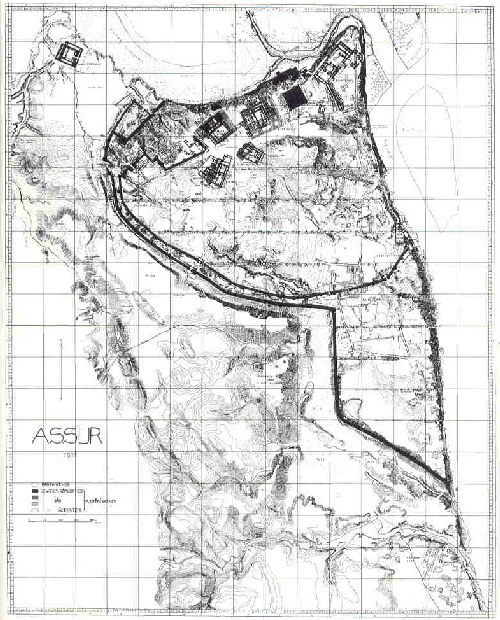|
Beginnings In 1821 the ruins of Ashur (Qal’at Sherqat) had been described by Claudius J. Rich. The first excavations started in 1840 under direction of William F. Ainsworth and did not show any significant results. Seven years later Henry A. Layard and Hormuzd Rassam started their work in Ashur and opened new trenches and tunnels. However a first extensive and systematic excavation had not taken place until the beginning of the 20th century with the expeditions of the German Oriental Society (Deutsche Orient-Gesellschaft). The Excavation of the German Oriental Society In 1903 the work of the German expedition had been initiated by Robert Koldewey, the excavator of Babylon. Soon he handed the direction over to Walter Andrae who continued the work until 1914. His excavations had been crowned with success: sanctuaries, palaces and fortifications were uncovered and documented. Private households and graves were laid open in several test trenches within a dense inhabited residential area. The highest levels revealed Parthian and Neo-Assyrian layers, in deep soundings temples and remains of habitations from the 2nd and 3rd millennium were uncovered. Several finds - pottery and household appliances, weapons and adornment, architectural elements and foundation deposits, private and official document archives - enrich the collections in Berlin, Istanbul and London. The publication series which started at the beginning of the excavations, has been continued by the German Oriental Society and is still ongoing till now. The Iraqi Expeditions In the 70ies and 80ies the Department of Antiquities and Heritage, Baghdad started their excavations in Ashur. At several areas within the municipal area mainly private houses dating to the Parthian, Neo- and Middle Assyrian period were laid open. After the Second Golf War work was interrupted for a while. From 1998 till 2002 Iraqi archaeologists had been working in Ashur again. Apart from Neo-Assyrian houses and Parthian tombs in the city’s centre, in the eastern part of the main tell, where a modern graveyard is situated, an unknown late Neo Assyrian palatial building was uncovered. New Excavations German excavations were led by Reinhard Dittmann from 1988 till 1989 (FU Berlin). He opened a deep sounding east of the Ishtar temple. In the years of 1889 and 1990 Barthel Hrouda (University of Munich) led expeditions in Ashur. The western part of the tell got explored by magnetometic prospection. The following excavations were interrupted by the outbreak of the Second Gulf war. Excavations were resumed not before spring 2000 and continued in autumn of 2001 as project of the German Research Foundation (DFG) in cooperation with the University of Halle, the German Oriental Society and the Bavarian Academy of Sciences and Humanities. The trenches opened in the late eighties in the western part of the city and in the east of the Ishtar temple were extended. Another area was opened at the central mound (“hill of graves”) where layers dating from the late 3rd millennium B.C. to the Islamic Middle Ages were supposed to be investigated. These excavations were undertaken under the direction of Peter A. Miglus (now University of Heidelberg).
 Ashur according to W. Andrae’s excavation 1903-1914.
|